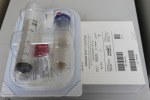 IRAP II
IRAP II
Joint inflammation involves changes in the joint fluid on a molecular level, including the release of inflammatory mediators. One of the main inflammatory mediators involved is interleukin-1 (IL-1), which plays a key role in accelerating tissue destruction. IL-1 antagonist (IL-1a) is a molecule that blocks the effects of IL-1. In a healthy joint, IL-1 and IL-1a are in balanced concentrations. In an inflamed joint, IL-1 production is increased without a compensatory increase in IL-1a, resulting in inflammation, pain, and deterioration of the joint.
IRAP stands for interleukin receptor antagonist protein. In the IRAP II system, blood is drawn and incubated in a syringe with special glass beads to produce interleukin receptor antagonist protein (IRAP). After incubation, the serum is extracted and separated into several doses (usually 4-8 doses are obtained, depending on the sample). The doses can be used immediately or frozen for up to a year. The IRAP is injected directly into the joint, where it acts as an anti-inflammatory by blocking the effects of inflammatory mediators such as IL-1.
For more information, see the IRAP II Informational Brochure.

